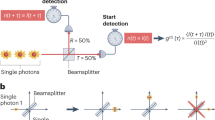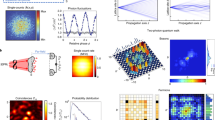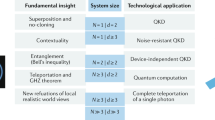Abstract
One hundred years ago Albert Einstein introduced the concept of the photon. Although in the early years after 1905 the evidence for the quantum nature of light was not compelling, modern experiments — especially those using photon pairs — have beautifully confirmed its corpuscular character. Research on the quantum properties of light (quantum optics) triggered the evolution of the whole field of quantum information processing, which now promises new technology, such as quantum cryptography and even quantum computers.
This is a preview of subscription content, access via your institution
Access options
Subscribe to this journal
Receive 51 print issues and online access
$199.00 per year
only $3.90 per issue
Buy this article
- Purchase on Springer Link
- Instant access to full article PDF
Prices may be subject to local taxes which are calculated during checkout









Similar content being viewed by others
References
Einstein, A. Zur Elektrodynamik bewegter Körper. Ann. Phys. 17, 891–921 (1905).
Einstein, A. Über einen die Erzeugung und Verwandlung des Lichtes betreffenden heuristischen Gesichtspunkt. Ann. Phys. 17, 132–148 (1905).
Lewis, G. N. The conservation of photons. Nature 118, 874–875 (1926).
Clauser, J. F. Experimental distinction between the classical and quantum field-theoretic predictions for the photoelectric effect. Phys. Rev. D 9, 853–860 (1974).
Burnham, D. C. & Weinberg, D. L. Observation of simultaneity in parametric production of optical photon pairs. Phys. Rev. Lett. 25, 84–87 (1970).
Jennewein, T., Achleitner, U., Weihs, G., Weinfurter, H. & Zeilinger, A. A fast and compact quantum random number generator. Rev. Sci. Instrum. 71, 1675–1680 (2000).
Kimble, H. J., Dagenais, M. & Mandel, L. Photon antibunching in resonance fluorescence. Phys. Rev. Lett. 39, 691–695 (1976).
Diedrich, F. & Walther, H. Nonclassical radiation of a single stored ion. Phys. Rev. Lett. 58, 203–206 (1987).
Taylor, G. I. Interference fringes with feeble light. Proc. Camb. Phil. Soc. Math. Phys. Sci. 15, 114–115 (1909).
Grangier, P., Roger, G. & Aspect, A. Experimental evidence for a photon anticorrelation effect on a beam splitter: a new light on single-photon interference. Europhys. Lett. 1, 173–179 (1986).
Dopfer, B. Zwei Experimente zur Interferenz von Zwei-Photon Zuständen: Ein Heisenbergmikroskop und Pendellösung. PhD thesis, Universtät Innsbruck (1998).
Zeilinger, A. Experiment and the foundations of quantum physics. Rev. Mod. Phys. 71, S288–S297 (2000).
Feynman, R. P., Leighton, R. B. & Sands, M. L. The Feynman Lectures on Physics Vol. 3 (Addison-Wesley, Massachusetts, 1965).
Brukner, C. & Zeilinger, A. Nonequivalence between stationary matter wave optics and stationary light optics. Phys. Rev. Lett. 79, 2599–2603 (1997).
Hong, C. K., Ou, Z. Y. & Mandel, L. Measurement of subpicosecond time intervals between two photons by interference. Phys. Rev. Lett. 59, 2044–2046 (1987).
Mattle, K., Weinfurter, H., Kwiat, P. G. & Zeilinger, A. Dense coding in experimental quantum communication. Phys. Rev. Lett. 76, 4656–4659 (1996).
Bohr, N. in Albert Einstein: Philosopher-Scientist VII (ed. Schilipp, P. A.) Vol. 7, 201–241 (Library of Living Philosophers, Evanston, 1949).
Englert, B. -G. Fringe visibility and which-way information: An inequality. Phys. Rev. Lett. 77, 2154–2157 (1997).
Wheeler, J. A. in Problems in the Foundations of Physics. Proc. Intl. School of Physics ‘Enrico Fermi’, Course LXXII. (ed. di Francia, G. T.) 395–492 (North-Hollands, Amsterdam, 1979).
Scully, M. O. & Drühl, K. Quantum eraser: A proposed photon correlation experiment concerning observation and “delayed choice” in quantum mechanics. Phys. Rev. A 25, 2208–2213 (1982).
Zou, X. Y., Wang, L. J. & Mandel, L. Induced coherence and indistinguishability in optical interference. Phys. Rev. Lett. 67, 318–321 (1991).
Einstein, A., Podolsky, B. & Rosen, N. Can quantum mechanical description of physical reality be considered complete? Phys. Rev. 47, 777–780 (1935).
Bell, J. S. On the Einstein Podolsky Rosen paradox. Physics 1, 195–200 (1964).
Freedman, S. J. & Clauser, J. F. Experimental test of local hidden-variable theories. Phys. Rev. Lett. 28, 938–941 (1972).
Aspect, A., Grangier, P. & Roger, G. Experimental realization of Einstein-Podolsky-Rosen-Bohm Gedankenexperiment: A new violation of Bell's inequalities. Phys. Rev. Lett. 49, 91–94 (1982).
Aspect, A., Dalibard, J. & Roger, G. Experimental test of Bell's inequalities using time-varying analyzers. Phys. Rev. Lett. 49, 1804–1807 (1982).
Weihs, G., Jennewein, T., Simon, C., Weinfurter, H. & Zeilinger, A. Violation of Bell's inequality under strict Einstein locality conditions. Phys. Rev. Lett. 81, 5039–5043 (1998).
Rowe, M. A. et al. Experimental violation of a Bell's inequality with efficient detection. Nature 409, 791–794 (2001).
Greenberger, D. M., Horne, M. A. & Zeilinger, A. in Bell's Theorem, Quantum Theory, and Conceptions of the Universe (ed. Kafatos, M.) 73–76 (Kluwer, Dordrecht, 1989).
Greenberger, D. M., Horne, M. A., Shimony, A. & Zeilinger, A. Bell's theorem without inequalities. Am. J. Phys. 58, 1131–1143 (1990).
Pan, J. -W., Bouwmeester, D., Daniell, M., Weinfurter, H. & Zeilinger, A. Experimental test of quantum nonlocality in three-photon Greenberger–Horne–Zeilinger entanglement. Nature 403, 515–518 (2000).
Turchette, Q. A., Hood, C. J., Lange, W., Mabuchi, H. & Kimble, H. J. Measurement of conditional phase shifts for quantum logic. Phys. Rev. Lett. 75, 4710–4713 (1995).
Rauschenbeutel, A. et al. Step-by-step engineered multiparticle entanglement. Science 288, 2024–2028 (2000).
Legero, T., Wilk, T., Kuhn, A. & Rempe, G. Time-resolved two-photon quantum interference. Appl. Phys. B 77, 797–802 (2003).
Pinkse, P., Fischer, T., Maunz, P. & Rempe, G. Trapping an atom with single photons. Nature 404, 365–368 (2000).
Hood, C. J., Lynn, T. W., Doherty, A. C., Parkins, A. S. & Kimble, H. J. The atom-cavity microscope: Single atoms bound in orbit by single photons. Science 287, 1447–1453 (2000).
Nogues, G. et al. Seeing a single photon without destroying it. Nature 400, 239–242 (1999).
Wiesner, S. Conjugate coding. SIGACT News 15, 78–88 (1983).
Bennett, C. H. & Brassard, G. in Proc. IEEE Intl.Conf. on Computers, Systems and Signal Processing 175–179 (IEEE, Bangalore, 1984).
Ekert, A. K. Quantum cryptography based on Bell's theorem. Phys. Rev. Lett. 67, 661–663 (1991).
Bennett, C. H. et al. Teleporting an unknown quantum state via dual classical and Einstein-Podolsky-Rosen channels. Phys. Rev. Lett. 70, 1895–1899 (1993).
Bouwmeester, D. et al. Experimental quantum teleportation. Nature 390, 575–579 (1997).
Kwiat, P. G. et al. New high-intensity source of polarization-entangled photon pairs. Phys. Rev. Lett. 75, 4337–4341 (1995).
Tittel, W., Brendel, J., Zbinden, H. & Gisin, N. Violation of Bell inequalities by photons more than 10 km apart. Phys. Rev. Lett. 81, 3563–3566 (1998).
Aspelmeyer, M. et al. Long-distance free-space distribution of quantum entanglement. Science 301, 621–623 (2003).
Kurtsiefer, C. et al. A step towards global key distribution. Nature 419, 450 (2002).
Hughes, R. J., Nordholt, J. E., Derkacs, D. & Peterson, C. G. Practical free-space quantum key distribution over 10 km in daylight and at night. New J. Phys. 4 43, 1–43 (2002).
Stucki, D., Gisin, N., Guinnard, O., Ribordy, G. & Zbinden, H. Quantum key distribution over 67 km with a plug&play system. New J. Phys. 4 41, 1–41 (2002).
Gisin, N., Ribordy, G., Tittel, W. & Zbinden, H. Quantum cryptography. Rev. Mod. Phys. 74, 145–195 (2002).
Poppe, A. et al. Practical quantum key distribution with polarization entangled photons. Opt. Express 12, 3865–3871 (2004).
Marcikic, I., de Riedmatten, H., Tittel, W., Zbinden, H. & Gisin, N. Long-distance teleportation of qubits at telecommunication wavelengths. Nature 421, 509–513 (2003).
Ursin, R. et al. Quantum teleportation across the Danube. Nature 430, 849 (2004).
Briegel, H. -J., Dür, W., Cirac, J. I. & Zoller, P. Quantum repeaters: The role of imperfect local operations in quantum communication. Phys. Rev. Lett. 81, 5932–5935 (1998).
Żukowski, M., Zeilinger, A., Horne, M. A. & Ekert, A. K. “Event-ready-detectors” Bell experiment via entanglement swapping. Phys. Rev. Lett. 71, 4287–4290 (1993).
Jennewein, T., Weihs, G., Pan, J. -W. & Zeilinger, A. Experimental nonlocality proof of quantum teleportation and entanglement swapping. Phys. Rev. Lett. 88, 017903 (2002).
Blinov, B. B., Moehring, D. L., Duan, L. -M. & Monroe, C. Observation of entanglement between a single trapped atom and a single photon. Nature 428, 153–157 (2004).
Julsgaard, B., Sherson, J., Cirac, J. I., Fiurasek, J. & Polzik, E. S. Experimental demonstration of quantum memory for light. Nature 432, 482–486 (2004).
Gottesman, D. & Chuang, I. L. Demonstrating the viability of universal quantum computation using teleportation and single-qubit operations. Nature 402, 390–393 (1999).
Knill, E., Laflamme, R. & Milburn, G. A scheme for efficient quantum computation with linear optics. Nature 409, 46–52 (2000).
Sanaka, K., Jennewein, T., Pan, J. -W., Resch, K. & Zeilinger, A. Experimental nonlinear sign shift for linear optics quantum computation. Phys. Rev. Lett. 92, 017902 (2004).
Pittman, T. B., Fitch, M. J., Jacobs, B. C. & Franson, J. D. Experimental controlled-NOT logic gate for single photons in the coincidence basis. Phys. Rev. A 68, 032316 (2003).
O'Brien, J. L., Pryde, G. J., White, A. G., Ralph, T. C. & Branning, D. Demonstration of an all-optical quantum controlled-NOT gate. Nature 426, 264–267 (2003).
Gasparoni, S., Pan, J. -W., Walther, P., Rudolph, T. & Zeilinger, A. Realization of a photonic controlled-NOT gate sufficient for quantum computation. Phys. Rev. Lett. 93, 020504 (2004).
Raussendorf, R. & Briegel, H. J. A one-way quantum computer. Phys. Rev. Lett. 86, 5188–5191 (2001).
Walther, P. et al. Experimental one-way quantum computing. Nature (in the press).
Steane, A. Multiple particle interference and quantum error correction. Proc. R. Soc. Lond. A 452, 2551–2577 (1995).
Shor, P. in Proc. 37th Symp. on Foundations of Computer Science 15–65 (IEEE Computer Society Press, Los Alamitos, 1996).
Kuhn, A., Hennrich, M. & Rempe, G. Deterministic single-photon source for distributed quantum networking. Phys. Rev. Lett. 89, 679011–679014 (2002).
McKeever, J. et al. Deterministic generation of single photons from one atom trapped in a cavity. Science 303, 1992–1994 (2002).
Santori, C., Fattal, D., Vuckovic, J., Solomon, G. S. & Yamamoto, Y. Indistinguishable photons from a single-photon device. Nature 419, 594–597 (2002).
Grangier, P., Sanders, B. & Vuckovic, J. (eds) Focus on Single Photons on Demand New J. Phys. (Spec. Edn) 6, 85–100 (2004).
Brattke, S., Varcoe, B. T. H. & Walther, H. Generation of photon number states on demand via cavity quantum electrodynamics. Phys. Rev. Lett. 86, 3534–3537 (1999).
Kim, J., Takeuchi, S., Yamamoto, Y. & Hogue, H. H. Multiphoton detection using visible light photon counter. Appl. Phys. Lett. 74, 902–904 (1999).
Slusher, R. E., Hollberg, L. W., Yurke, B., Mertz, J. C. & Valley, J. F. Observation of squeezed states generated by four-wave mixing in an optical cavity. Phys. Rev. Lett. 55, 2409–2412 (1985).
Furusawa, A. et al. Unconditional quantum teleportation. Science 282, 706–709 (1998).
Schleich, W. P. Quantum Optics in Phase Space (Wiley-VCH, Berlin, 2001).
Bachor, H. -A. & Ralph, T. C. A Guide to Experiments in Quantum Optics 2nd edn (Wiley-VCH, Weinheim, 2004).
Grosshans, F., Assche, G. V., Wenger, J., Cerf, R. B. J. & Grangier, P. Quantum key distribution using gaussian-modulated coherent states. Nature 421, 238–241 (2003).
Dirac, P. A. M. Emission and absorption of radiation. Proc. R. Soc. Lond. A 114, 243–265 (1927).
Everett, H. “Relative state” formulation of quantum mechanics. Rev. Mod. Phys. 24, 454–462 (1957).
Bohm, D. A suggested interpretation of the quantum theory in terms of “hidden” variables. Phys. Rev. 85, 166–179, 180–193 (1952).
Rauschenbeutel, A. et al. Coherent operation of a tunable quantum phase gate in cavity QED. Phys. Rev. Lett. 83, 5166–5169 (1999).
Jennewein, T., Simon, C., Weihs, G., Weinfurter, H. & Zeilinger, A. Quantum cryptography with entangled photons. Phys. Rev. Lett. 84, 4729–4732 (2000).
Lenard, P. Über die lichtelektrische Wirkung. Ann. Phys. 8, 149–198 (1902).
Millikan, R. A. A direct photoelectric determination of Planck's h. Phys. Rev. 7, 355–388 (1915).
Millikan, R. A. Albert Einstein on his seventieth birthday. Rev. Mod. Phys. 21, 343–345 (1949).
Compton, A. H. The spectrum of scattered X-rays. Phys. Rev. 22, 409–413 (1923).
Bothe, W. & Geiger, H. Über das Wesen des Comptoneffekts; ein experimenteller Beitrag zur Theorie der Strahlung. Z. Phys. 32, 639–663 (1925).
Stuewer, R. The Compton Effect: Turning Point in Physics (Science History, New York, 1975).
Tu, L. -C., Luo, J. & Gillies, G. T. The mass of the photon. Rep. Prog. Phys. 68, 77–130 (2004).
Cocconi, G. Upper limits on the electric charge of the photon. Am. J. Phys. 60, 750–751 (1992).
Weinberg, S. Light as a fundamental particle. Phys. Today 28, 35–37 (1975).
Lawrence, E. O. & Beams, J. W. The element of time in the photoelectric effect. Phys. Rev. 32, 478–485 (1928).
Forrester, A. T., Gudmundsen, R. A. & Johnson, P. Photoelectric mixing of incoherent light. Phys. Rev. 90, 1691–1700 (1955).
Clauser, J. F. Experimental limitations to the validity of semiclassical radiation theories. Phys. Rev. A 6, 49–54 (1972).
Klein, M. J. Einstein's first paper on quanta. Nat. Phil. 2, 59–86 (1963).
Stachel, J. et al. in The Collected Papers of Albert Einstein (eds Stachel, J. et al.) Vol. 2, 134–148 (Princeton Univ. Press, Princeton, 1989).
Pais, A. Einstein and the quantum theory. Rev. Mod. Phys. 51, 863–914 (1979).
Clauser, J. F. in Quantum [Un]speakables: From Bell to Quantum Information (eds Bertlmann, R. A. & Zeilinger, A.) 61–98 (Springer, Heidelberg, 2002).
Acknowledgements
We acknowledge wonderful collaborations and challenging discussions with many colleagues and friends in the worldwide quantum optics community over the years.
Author information
Authors and Affiliations
Corresponding author
Ethics declarations
Competing interests
The authors declare no competing financial interests.
Rights and permissions
About this article
Cite this article
Zeilinger, A., Weihs, G., Jennewein, T. et al. Happy centenary, photon. Nature 433, 230–238 (2005). https://doi.org/10.1038/nature03280
Published:
Issue Date:
DOI: https://doi.org/10.1038/nature03280
This article is cited by
-
Applications of single photons in quantum metrology, biology and the foundations of quantum physics
Nature Reviews Physics (2023)
-
Unprovability of first Maxwell’s equation in light of EPR’s completeness condition: a computational approach from logico-linguistic perspective
Pramana (2023)
-
The Physical Foundation of Quantum Theory
Foundations of Physics (2023)
-
Celebrating entanglement
Nature Photonics (2022)
-
Constructivism and Realism in Boltzmann’s Thermodynamics’ Atomism
Foundations of Physics (2020)
Comments
By submitting a comment you agree to abide by our Terms and Community Guidelines. If you find something abusive or that does not comply with our terms or guidelines please flag it as inappropriate.



